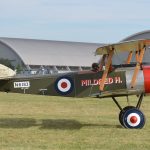![Kahului: Maui's Naval Air Station Turned Airline Gateway 10 A four-ship line abreast formation of Chance-Vought F4U Corsairs over the Hawaiian Islands during WWII. [Photo Credit: National Archives]](https://vintageaviationnews.com/wp-content/uploads/4-1.jpg)
By: Matthew McDaniel
On December 7th, 1941, the Empire of Japan launched its sneak attached on Pearl Harbor, grievously wounding the United States’ Pacific naval fleet. Yet, less than a year later, the Hawaiian Islands were bustling with all manner of Allied military activity. The islands quickly became a staging point for personnel and equipment destined to join the fight in the Pacific Theater’s island hopping campaign. The Territory of Hawaii soon contained training grounds for airmen, sailors, marines, and soldiers of all descriptions and responsibilities, undergoing their final training tasks before departure for the South Pacific’s active combat zones. As a result, Hawaii’s military facilities not only became buzzing beehives of activity, but quickly hit their peak capacities as well.
Such was the case at Naval Air Station (NAS) Pu’unene, located in the lush central valley of Maui, surrounded by large tracts of sugar cane fields. NAS Pu’unene was activated in 1940, well ahead of the U.S. entry into WWII. By mid-1942, its size and infrastructure were no longer sufficient to accommodate the volume of transient squadrons heading to the fleet and the various air bases closer to the war zones. Thus, the Navy proposed building a reliever air station nearby and began officially investigating the plan by September, 1942. They selected a location only five miles north of Pu’unene on land leased from the Hawaiian Commercial & Sugar Company. At the time, only sugar cane fields and dense stands of Kiawe trees covered the 1,300-acre plot. It took only two months to complete site surveys, hire an architectural engineer, draft the base’s initial layout, and approve a construction plan. On November 17th, 1942, only hours after field equipment arrived on site, a construction team broke ground on Maui’s second naval air station, by then designated NAS Kahului. Taking place less than a year after entering the war, the U.S. Navy’s urgency to relieve the burden placed on NAS Pu’unene is obvious in this aggressive time-line.
Four months later, on March 15th, 1943, NAS Kahului was commissioned and under charge of Commander Phil LeRoy Haynes, U.S. Navy. However, much work remained before the base became fully operational. It took another six months of fast-paced construction before flight operations could begin. At precisely 11:30am on September 20th, 1943, Commander Haynes himself landed the first aircraft, a Grumman JRF Goose, on the newly completed runway. Thereafter, NAS Kahului was truly open for business as Cmdr Haynes’ Goose was followed immediately by nine Douglas SDB Dauntless dive-bombers and a single Grumman F6F Hellcat fighter. The aircraft were all from Composite Squadron 23 and carrying personnel reporting for duty, along with their gear.
NAS Kahului initially had two runways: the 7,000′ long primary and a 5,000′ secondary. Its parking aprons could accommodate two complete Carrier Air Groups and there were enough revetments to protect 73 aircraft (61 fighters and 12 bombers). Up to 525,000 gallons of aviation fuel could be stored on-site. During the remainder of WWII, NAS Kahului would house nearly 6,000 military personnel, including approximately 900 Officers. Some 40 separate squadrons and many Carrier Air Groups trained there, perfecting their takeoff and landing techniques via simulated aircraft carrier operations conducted on the base’s runways.
The adjacent island of Kaho’olawe (7 miles southwest of Maui) was subjected to a regular barrage of bombs, torpedoes, and bullets during live-fire training runs from squadrons operating from both Maui and O’ahu air bases. In fact, the military unleashed so much ordnance on Kaho’olawe between 1942 and 1990, that access to the island is still all-but-prohibited. While the government has made significant progress towards clearing Kaho’olawe of unexploded ordnance, funds to complete the job have remained insufficient, leaving the island still too dangerous for human habitation.
Despite its highly active wartime years, Kahului’s life as a naval air station was destined to be a short one. The end of WWII abruptly rendered Maui’s two air bases excessive to US Navy requirements in the Hawaiian Islands. The Navy decommissioned NAS Kahului only months after Japan’s unconditional surrender, putting the facility into dormancy during 1946. The Hawaii Aeronautics Commission (HAC) took over management of the base in 1947. Kahului saw only low-volume freight and charter operations under that agreement. No firm decision to move all commercial flight operations from the former NAS Pu’unene to Kahului’s facilities took place until 1951, due mainly to the lengthy and complex negations required to transfer actual ownership from the U.S. Navy to the Territory of Hawaii. Once that happened, necessary repair and modernization projects at Kahului quickly got underway. The consensus was that as flight operations increased into the future, the superior location and facilities at Kahului would prove both safer and more economical to use than those at Pu’unene. So began a new era in NAS Kahului’s history: the civilian airport era.
Officially rechristened Kahului Airport (Identifier: OGG or PHOG), the civilian field was still home to military aircraft even in its early years. Specifically, the Hawaii National Guard based two Cessna L-19 Birddogs on the field, and the Coast Guard Auxiliary maintained an operations center there as well. In June 1952, full commercial airline service began from OGG, while Pu’unene was effectively abandoned. This consolidated all of Maui’s inter-island operations at Kahului, greatly easing the management tasks of the HAC. By late 1953, OGG had become the second busiest airport in the Territory; a distinction it still maintains. HAC steadily improved the airport and its facilities throughout the 1950’s and 60’s. Two significant milestones included the installation of an Instrument Landing System (ILS) for Runway 02-20 in 1963 (only the second ILS in the State at the time) and the dedication of a new airline terminal in 1966 (tripling passenger and baggage handling capabilities). In the early 1980’s commercial flight operations began between Maui and the mainland. This necessitated another wave of improvements, completed in phases, which culminated in a new $50Mil terminal opening in 1990. Continuous improvements at PHOG have never really stopped since then, the airport keeping pace with the growing demand in passenger and freight operations, general aviation, and FAA regulatory requirements.
While Kahului’s military history is rich, it perhaps gained its greatest notoriety for a flight that was neither scheduled to depart, nor arrive there. On April 28th, 1988, Aloha Airlines Flight 243 took off from Hilo Airport on Hawaii’s big island, bound for Honolulu International. The Boeing 737’s emergency diversion into Kahului became one of the most famous aviation calamities in U.S. history. Metal fatigue caused an 18-foot section of the aircraft’s forward/upper fuselage to separate, causing an explosive decompression. Tragically, a flight attendant was sucked out and fell to her death. Several passengers sustained severe injuries in the incident as well. In spite of nearly impossible odds, the flight crew maintained control and successfully landed the stricken Boeing at Kahului, saving the lives of the remaining 65 passengers and crew on board. The after-effects of this landmark accident resonated throughout the aviation industry and initiated sweeping changes in the way airliners are built, maintained, inspected, and operated.
Today, Kahului is still second only to Honolulu International Airport in terms of air traffic (within Hawaii) and is the 51st busiest airport in the United States. The top markets to and from OGG are Honolulu, Los Angeles, San Francisco, and Seattle. Hawaiian Airlines now dominates at Kahului with over 50% of the daily flights (mostly on inter-island routes), while Alaska and United Airlines each account for just over 10% of operations (mostly with their services to/from mainland airports). Future plans for PHOG call for runway extensions, facility expansion and improvements, leading hopefully to the airport becoming a true international gateway by welcoming direct flights from nations around the globe. To that we say; “Mahalo, Kahului!”
About The Author: Matthew McDaniel is a Master & Gold Seal CFII, ATP, MEI, AGI, & IGI and Platinum CSIP. In 26 years of flying, he has logged 16,000 hours total and over 5,500 hours of instruction-given. Currently, he flies the Airbus A-320 series for an international airline, holds eight turbine aircraft type ratings, and has flown over 80 aircraft types. Matt is one of 25 instructors in the world to have earned the Master CFI designation for 7 consecutive two-year terms. He’s been a freelance aviation author since 2003 and owns Progressive Aviation Services, LLC. He can be reached at: [email protected] or +1-414-339-4990.
Copyright 2016, Matthew McDaniel. First publication rights granted WarbirdsNews. All other rights reserved by copyright holder.








![Kahului: Maui's Naval Air Station Turned Airline Gateway 11 An aerial view of NAS Kahului during WWII. [Photo Credit: National Archives]](https://vintageaviationnews.com/wp-content/uploads/1-1.jpg)
![Kahului: Maui's Naval Air Station Turned Airline Gateway 12 A U.S. Navy Grumman JRF Goose. The same type was the first aircraft to land on a NAS Kahului runway, under the control of base Commander Phil Haynes. [Photo Credit: National Archives]](https://vintageaviationnews.com/wp-content/uploads/2-1.jpg)
![Kahului: Maui's Naval Air Station Turned Airline Gateway 13 A July 1944 Landing Chart for NAS Kahului, Maui. Note the CONFIDENTIAL notation at the bottom left. [Photo Credit: National Archives]](https://vintageaviationnews.com/wp-content/uploads/5-1.jpg)
![Kahului: Maui's Naval Air Station Turned Airline Gateway 14 A squadron of TBM Avengers tied down in Hawaii during WWII. [Photo Credit: National Archives]](https://vintageaviationnews.com/wp-content/uploads/3-1.jpg)
![Kahului: Maui's Naval Air Station Turned Airline Gateway 15 Aloha Airlines Boeing 737 (-200 Series) on the tarmac of Kahului Airport (OGG) in 1988. The major structural failure killed one flight attendant, severely injured several passengers, and caused the flight crew to make an emergency diversion and landing at OGG. [Photo Credit: Wikipedia]](https://vintageaviationnews.com/wp-content/uploads/6-1.jpg)
![Kahului: Maui's Naval Air Station Turned Airline Gateway 16 One of the most recent airline service additions at PHOG is Virgin America service to/from both San Francisco and Los Angeles, CA in ETOPS-approved Airbus A-320's. [Photo Credit: mauinow.com]](https://vintageaviationnews.com/wp-content/uploads/7mauinow.com_.jpg)















